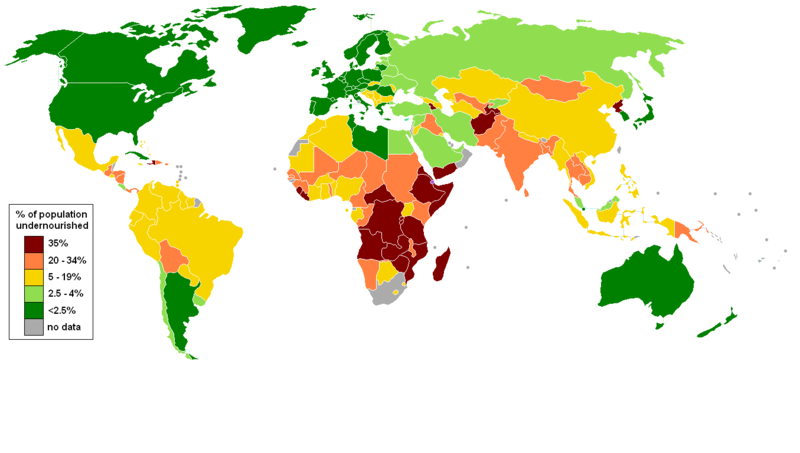Starvation
|
Starvation Microchapters |
|
Diagnosis |
|---|
|
Treatment |
|
Case Studies |
|
Starvation On the Web |
|
American Roentgen Ray Society Images of Starvation |
Editor-In-Chief: C. Michael Gibson, M.S., M.D. [1]
Overview
Starvation is a severe reduction in vitamin, nutrient, and energy intake, and is the most extreme form of malnutrition.
Epidemiology and Demographics

According to the Food and Agriculture Organization of the United Nations, more than 25,000 people died of starvation every day in 2003,[1] and as of 2001 to 2003, about 800 million people were chronically undernourished.[2][1]
Causes of Starvation in Alphabetical Order
- Anorexia nervosa
- Bulimia nervosa
- Clinical Depression
- Coma
- Crash dieting
- Diabetes mellitus (untreated)
- Digestive disease
- Famine
- Fasting
- Malnutrition
- Overpopulation
- Poverty
Natural History, Complications, Prognosis
In humans, prolonged starvation (in excess of 1-2 months) causes permanent organ damage and, eventually, death.
Complications
- Immune deficiency may occur.
- Vitamin deficiency is also a common result of starvation, often resulting in anemia, beriberi, pellagra, and scurvy. These diseases collectively may cause diarrhea, skin rashes, edema, and heart failure. Individuals are often irritable, fatigued, and lethargic as a result.
Psychological effects of starvation
Through several reports and studies, scientists have discovered that starvation has many psychological effects on a person, in addition to its physiological effects.[3] The most extensive and informative study on starvation's psychological effects is called The Minnesota Starvation-Rehabilitation Experiment, which was carried out from 1944-1946. The subjects of this experiment were thirty-two healthy conscientious objectors, ages twenty to thirty-three.[3] Subjects experienced three phases of the experiment: twelve weeks of control period, twenty four weeks of semistarvation, and then twelve weeks of rehabilitation. During the control experiments, subjects were given 3,492 calories, during the period of semistarvation, calories were decreased to 1,570, and during the period of rehabilitation, they were re-increased to normal levels. During the period of semistarvation, subjects were fed foods most likely consumed in European famine areas.[3] The results of the starvation experiment were tested in many ways. According to Josef Brozek, author of Psychology of Human Starvation and Nutritional Rehabilitation, studies "ranged from intelligence and personality tests through ratings to purely descriptive material, provided by the experimenters' notes and diaries kept by the subjects".[3] According to subjects of the semistarvation experiment, tiredness was the worst effect of the low calorie intake, followed by appetite, muscle soreness, irritability, apathy, sensitivity to noise, and hunger pain.[3] Standard personality tests revealed that the starving individuals experienced a large rise in the "neurotic triad" -- hypochondriasis, depression, and hysteria. Also, the subjects of the experiment noticed a marked decrease in the drive for activity, and a remarkable decrease in sex drive.[3] In peer evaluations, other experiment subjects noted great changes in subjects' personalities during the period of semistarvation. In interviews years later, subjects reported that they felt that they had not returned to normal by the end of the three month recovery period.[4] Subjects' own estimates of the time it took for recovery ranged from two months to two years.[4] Many subjects reported that they grossly overate and put on fat after the experiment due to the urge to eat.[4]
Diagnosis
Symptoms

Vitamin deficiency is also a common result of starvation, often resulting in anemia, beriberi, pellagra, and scurvy. These diseases collectively may cause
Other symptoms include:
Physical Examination
General
- Cachexia is present as individuals experiencing starvation lose substantial fat and muscle mass as the body breaks down these tissues for energy.
Laboratory Findings
- Ferritin levels may be raised (serum)
- Hypoglycaemia
- Ketoacidosis
- Ketosis
- Kaliuresis (elevated urine potassium)
- Thyroid hormone binding globulin levels may be low
- Hyperuricemia (elevated uric acid levels)
- Urine pH may be low
ECG abnormalities
See also
- Refeeding syndrome
- Anorexia
- Anorexia nervosa
- Cachexia
- Dehydration
- Famine
- Famine response
- Famine scales
- Fasting
- Hunger
- Malnutrition
- Kwashiorkor
- Marasmus
- Overpopulation
- Hunger strike
- List of countries by fertility rate
References
- ↑ 1.0 1.1 Kirby, Alex (2003-03-05). "UN warns of future water crisis". BBC. Retrieved 2007-09-01.
- ↑ "The spectrum of malnutrition" (pdf). Food and Agricultural Organization. 2001-10-05. Retrieved 2007-08-03.
- ↑ 3.0 3.1 3.2 3.3 3.4 3.5 Brozek, Josef. "Psychology of Human Starvation and Nutritional Rehabilitation." The Scientific Monthly 70 (1950): 270-274.
- ↑ 4.0 4.1 4.2 Kalm LM, Semba RD (2005), They starved so that others be better fed: remembering Ancel Keys and the Minnesota experiment. Journal of Nutrition, Volume 135, Issue 6, Pages 1347-1352. Retrieved on September 13, 2007.
Template:Consequences of external causes
de:Unterernährung
eo:Malsatmorto
ko:기아
hi:भुखमरी
it:Inedia
lt:Badavimas
no:Sult
simple:Starvation
sv:Svält